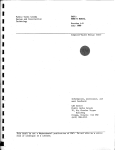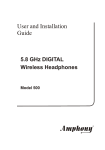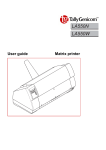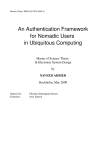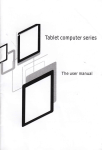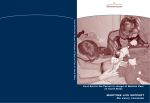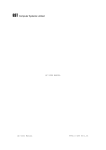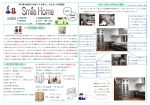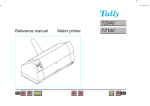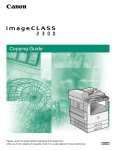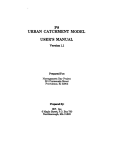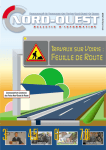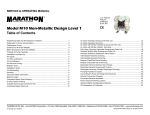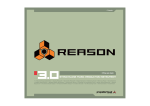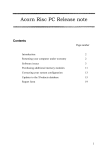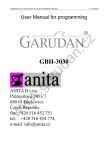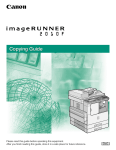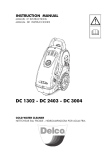Download GST Computer Systems Limited
Transcript
68K / ASM Assembler
GSl-computer Systems Limited
68K /ASM
ASSEMBLER
USER
Copyright
68K/ASM User Manual
~
MANUAL
1984 GST Computer Systems Limited
1
8290.6 GST 68/1.03
GST Computer Systems Limited
68K/ASM Assembler
CONTENTS
1. 1
1 .2
1.3
INTRODUCTION
Copyright
Making a Backup Copy
Notation Used in this Manual
2
2.1
2 .2
2 .3
HOW TO RUN THE ASSEMBLER
Loading the Program
Command Line Format
Command Line Options
3
ASSEMBLER INPUTS AND OUTPUTS
Control Inputs
Source Inputs
Library Input
Screen Output
Source Listing
Symbol Table Listing
Object Code Output
3 .1
3 .2
3.3
3.4
3.5
3.6
3. 7
~.
4.1
4.2
LISTING OUTPUTS
Source Listing
Symbol Table Listing
APPENDICES
A
BIBLIOGRAPHY
B
B.l
B. 2
B·3
B. 4
B. 5
B.6
SOURCE LANGUAGE
Lexical Analysis
Source Language Line Format
Expressions
Addressing Modes
Instructions
Assembler Directives
C
C.l
C. 2
C. 3
ERROR AND WARNING MESSAGES
Error Messages
Warning Messages
Operating System Error Messages
68K/ASM User Manual
8290 .6 CST 68/1.03
GSI
68K/ASM Assembler
Computer Systems Limited
I
INTRODUCTION
This manual tells you how to l:se 68K/ ASM which is the assembler for the
68K/OS operating system produced by GST Computers Systems Limited.
It tells you:
*
how to load and run the assembl er
*
what inputs the assembler takes and what outputs it produces
*
how the assembler language instructions should be coded
*
what assembler directives are available, what they do, anc how to
code them.
It does not:
*
include a detailed description of the instruction set of the
Motorola Mc68000 processor family for which you will need
additional documentation
*
tell you how to t.alk to 68K/OS for "ihich you \dll have to consult
the 68K/OS Programmer ' s Manual
*
teach programming in general
*
teach assembler programming or 68000 programming in particular .
Appendix A contains a list. of some other publications which you may
find helpful.
1. 1
Copyright
This manual and the 68K/ASM assembler software are
Copyright
~ 1984 GST Computer Systems Limited
a nd may not be copied by any means whatsoever without prior written
permission from GST Computer Systems Limited.
Permission is ~ereby granted to make copies of the software for
security or backup purposes only .
].2
Making a Backup Copy
It is strongly recommended tha t you make a backup copy of the supplied
tapE' before using the assembler. The procedures for doing this are
fully described in the 68K /OS User Manual.
First you take a blank tape and format i t using the 68K/OS FORMAT
program.
Then COPY eve ry file on t.he supplied assembler tape to the
newly formatted blank t a pe.
He suggest that you use thE' new t a pe for
running t.he assembler and keep the , supplied tap e as t.he backup copy.
68K/ASM User Manual
3
8290. 6 GST 68/1.03
GST Comp ute r Systems Limited
1.3
68K/ASM Assembler
Notation Used in t his Manual
This section describes the notation used throughout the manual to
describe syntax of assembler source, as well as other items.
means that the expression on the right defines the meaning of
the item on the left, and can be read as "is "
< >
angle brackets containing a lower-case name - represent a named
item which is itself made up from simpler items, such as
<decimal number>
a vertical bar indicates a choice and can be read as "or is "
[ 1
square brackets indicate an optional piece of syntax that may
appear 0 or 1 times
[ )
curly brackets indicate a repeated piece of syntax that may
appear 0 or more times
is used informally to denote an obvious range of choices,
in:
<digi t>
as
= 0 11 1 . . . 1819
Other symbols stand for themselves .
Example
<binary number>
-%<binary digit>{<binary digit»
<binary digit>
means that a binary number is a ' %' sign followed by a binary digit,
followed by any number of further binary digits, where a binary digit
is the character '0' or the character ' 1'. Some examples of binary
numbers are r~, %1010101100, r~OOOOOOOOOOOO .
Some of the special symbols used in the syntax notation also occur in
the assembler source input and the common sense of the reader is relied_
on to distinguish t.hese, as in for example:
<operator>
68K/ASM User Manual
= ... I « I .•.
4
8290.6 CST 68/1.03
GST Computer Systems Limited
68K /ASM Asse mbler
c'
HOW TO RUN THE ASSEMBLER
2,1
Loading the Program
To run the assemble r, a microdrive containing ASM . PROG should be
mounted and the program started by typing ASM.PROG in ADAM ' s commanc
line, followed by ENTER. (If the microdrive cartridge has not been set
as the program or data default directory you will need to precede the
program name with a. directory name _. see the 68K/OS L:ser Manual).
If this file is present on the tap e and provided no I/O errors are
det ected , the assembler will b e loaded.
It will open c. large green
window (whose SiZE car. be adjus ted using the gro;: and s hrink functions)
and will output its f..ame, r e vision r,umber and a command line prompt.
2.2
Command Line Format
The format of the command line is:
<source> [ <list ing > [<binary>]] {<option>]
where:
<option >
-NOLIST
-ERRORS [<listing>]
-NOBIN
-BIN
-NOSYM
- SYM
-LIBRARY <library>
-LIST [<listing>]
I
[<binary>]
I
-LIB <library>
(the options may be in upper or lower case and case is
not significant)
<source>
<lis ting >
<binary >
<library >
2·3
<file
<file
<fi le
<file
name>
name>
name>
name>
file
file
file
file
name
name
name
name
of assembler source
for listing output
for binary output
for library input
Command Line Options
The options have the following meanings:
-NOLIST
du not generate any listing output
-ERRORS
generate a listing of error messages a.nd erroneous lines
only; if the option is followed by a <file name> then
this is the name cf the <listi ng> output and the
posi tional <lis ting > parameter, if specified, is not
t:.sed ; the -ERRORS option also sets the -NOSYM option
68K/ASM User Manual
8290.6 GST 68/1.03
GST Computer Systems Limited
68K/ASM Assembler
-LIST
generate a full listing;
if the option is followed by a
<file name> then t.his is t.he name of t.he <listing>
output and the positional <listing> parameter, if
specified, is ignored
-NOBIN
do not generate any binary output
-BIN
generate binary output;
if the option i s followed by a
<file name> then this is the name of the <binary> output
file and the positional <binary> parameter, if
specified, is ignored
-NOSYM
do not generate a symbol table listing;
default if -ERRORS is specified
-SYM
generate a symbol table listing;
this is t.he default if
-LI ST is specified or if no listing options are
specified;
if -SYM and -NOLIST are both npecified then
the - SY M is ignored
-LIBRARY
(or -LIB) the -LIBRARY option must be followed by a
<file name> and specifies a file containing a
precompiled library to be included in the assembly
this is the
Where conflicting options are given the last one specified takes
effect.
For example , if:
-LIST mydir/fred.list -NOLIST -ERRORS
is specified then only an error listing is sent to MYDIR/FRED.LIST, and
if:
- SYM -ERRORS
is specified then no symbol t.able output will be generated.
The minimum command line just consists of the name of the input. source
file.
In this case a full listing with symbol table is generated (i. e.
the default is -LIST -SYM) to the file whose name is constructed from
the <source> <file name> as described below.
Also by default a binary
output file is generated (Le. the default is -BIN) to the file whose
name is constructed from the <source> <file name> as described below.
The <source> file name is examined:
if it does not contain a file
exten sion component then ". ASM " is appended to the given name to make
the name of the actual source file used.
The name of the <listing> file may be given positionally as the second
parameter, or may be specified explicitl y after a -ERRORS or - LIST
option, or may be a llowed to default . If no <listing> <file name> is
given in a -ERRORS or -LIST option and no -NO LI ST option has been
specified then the assembler constr ucts the <listing> <file name> by
taking the <source> <file name> and replacing the fHe type with
" .LIST" .
68K / ASM User Manual
6
8290.6 CST 68/1.03
GSI
68K/ASM Assembler
Co mputer Systems Limited
The name of the <binary> file may be give~ positionally as the third
parameter, or may be Gpecified explicitly after a -BIN option, or nay
be allowed to default. If no <binary> <filE, name> is given in a -BIN
option ".nd no -·NOBIN option has been coded thel'\ the assembler
constructs the <binary> <filE' name> by taking the <source> <filE, name>
and replacing the file extension with ".BIN:.
Examples:
FRED
8.ssemble FRED.ASM, put a full listing with symbol table listing in
FRED.LIS'!' an(l put the binary in FRED. BIN
FRED TXl: -nob in
8.ssemble FRED.ASM, print the listing as it is produced,
generate any binary
and don't
FRED -errors -BIN other/fred . bin
c.ssemble FRED.ASM, send an error listing only with (0 symbol table
to FRED . LIST and put the binary in OTHER/FRED.BIN (note that
coding OTHER/FRED would not have 8.chieved this)
FRED txl: other/fred. bin -errors -sym -LIBRARY system /68kos. lib
8.ssemble FRED.ASM, print an error listing plus symbol table
directly, put the binary in OTHER/FRED.BIN and include the
precompiled file SYSTEM/68KOS.LIB in tl;te output binary
When the assembly has finished, and if there have been no operating
system errors, the assembler will not terminate but will repeat the
prompt asking for a command line.
You can now do another assembly
without having to reload the assembler.
When you have done all the
assemblies that you want you may reply to this prompt with ENTER and
the assembler will terminate.
68K/ASM User Manual
7
8290.6 GST 68/1.03
GSI
68K/ASM Assembler
Computer Systems Limited
3
ASSEMBLER INPUTS AND OUTPUTS
This chapter describes all t.he input and output files Gnd devices that
the assembler can use.
3.1
Control Inputs
Control information for t.he assembler is supplied by the user typing a
command line on the keyboard.
The command line is described in
section 2 above and specifies where 8.11 the other input and output
files and devices are.
3.2
Source Inputs
The assembler a.ssembles one main source file.
This may direct the
assembler, using INCLUDE directives, to read other source files.
When assembling large and complicated programs j t is normal to put no
real code at all in the main source file which will just contain
INCLUDE directives naming the other source files . For example:
TITLE
*
*
*
*
*
*
*
*
*
*
*
*
*
*
A large complicated assembly
Start with the 68K /OS parameter file, then the
parameter file for my program
INCLUDE
INCLUDE
system /68kos .in
myparms.in
Now the main code to be assembled: this is rather
large so it is split into two separate files
INCLUDE
INCLUDE
progl.in
prog2. in
Finally, the -LIBRARY facility is being used to
include a library of useful subroutines;
the
declaration file for the library must be INCLUDEd
last
INCLUDE
library. in
END
It is recommended that filenames of main source files end in ".ASM",
but this is not a requirement and you can call them anything you like.
It is recommended that filenames of INCLUDEd files end in ". IN", but
this is not a requirement and you can call them anything you like.
Note that 68K /ASM will search for any INCLUDEd files on the default
data directory unless a directory is specified within the INCLUDE
directive.
68K/ASM User Manual
8
8290 . 6 CST 68/1.03
GSI
68K/ASM Assembler
Computer Systems Lim ited
3.3
Library Input
The assembler's library mechanism allows you to include in your program
a previously assembled binary file containing useful subroutines or
other code. The program being assembled may refer to labels within the
library, but the library must be self-contained and cannot refer to
labels elsewhere in the program.
To use a library you must make reference to two files.
The first file is a set of symbol definitions, in normal a.ssembler
sourc e format, which you must INCLUDE at the end of your source
program.
This file causes your references to library symbols to be
resolved. so that your code can be assembled.
The second file is a binary file contain i ng the code of the library
routines. You must present this to the assembler by giving its name in
the -LIBRARY option on the command line.
If you manage to leave out one of these two files, or use a definition
file that is not compatible . with the binary file, then undefined chaos
will result.
You can build. your own libraries o.s follows:
(a)
write the code
(b)
assemble it:
binary file
(c)
build a definitions file from the symbol table listing resulting
from the assembly:
for each symbol in the library which you wish
to be able to access from programs, write a line:
symbol
the output from the assembler is now the library
EQU
*+offset
where offset is the value printed for the symbol on the listing.
You can extend libraries in the obvious way as the assembly in step (b)
above can itself use a library.
68K/ASM User Manual
9
8290 . 6 CST 68 /1.03
GST Computer Systems Limited
68K/ASM Assembler
3.4 Screen Output
In addition to the identification message and command line prompt
when the assembler starts, the following are output to the screen.
The assembler makes two passes of the source input files and will tell
you when it starts each pass . The second pass can be expected to take
a lot longer than the first pass if lis·tings and/or binary output are
wanted.
The symbol table list ing is produced after the · summary
messages are displayed, so if you are assembling a large program it
will be an appreciable time after the summary messages are displayed
before the assembler finishes completely.
A s ummary of the number of errors and warnings generated is written to
the screen together with a summary of the amount of memory used. This
memory size excludes the memory occupi ed by the code of the assembler
itself (about 17k) and the assembler's initial data space (about 6k).
You can get a good idea of how complex your assemblies are and whether
you are likely to run out of memory by watching the memory use figure.
If you do several assemblies in one go (without reloading the
assembler) then the assembler will re-use any memory it has obtained
from the operating system but will not release any memory until it
terminates completely. This means, for e xample, that if you do a very
large assembly followed by a very small assembly there will be no more
free memory in the machine during the small assembly than there was
during the large assembly.
3.5 Source Listing
An optional source listing will be generated,
and the code that has been generated.
showing the source input
The listings provided are controlled both by options on the command
line (see section 2 above) and by directives coded in the source
program (see appendix B below).
If the -NO LIST option is g iven then there will be no listing output
from the assembler. Under all other circumstances a file or device
will be used to produce a listing.
If the filename for the listing output is generated automatically by
the assembler it will end in .LIST.
It. is recommended that listing
files a.lways have filenames ending in .LI ST, but this is not a
requirement and you can call them anything you like .
Listings can be printed directly as they are generated (using TX1: or
whatever is appropriate to your hardware and your implementation of
68K/OS) or can be sent to the screen (us ing SCREEN:) as s.n Elternative
to sending them to files.
68K/ASM User Manual
JO
8290.6 CST 68 /1. 03
GSI
68K /ASM Assembler
Computer Systems Limited
3.6
Symbol Table Listing
A sym bol table listing will be produced if both the -LIST and -SYM
options are in effect.
The symbol table listing will be a.dded to the end of t.he source
listing, starting on a new page.
3.7
Object Code Output
The a.ssem bler produces a binary file whi c h can be loaded and run
directlY as a 68K / OS program, provided that you have coded the required
control information (th e Program Header Block) at. the start of the
program. For detaUc consult the 68K/OS Programmer's Reference Manual.
Alternatively the output binary file from the assembler can be a.
library file which is not directly executable but can be included in
future assemblies.
There is no difference between the format of a
library file and the format of an executable program file:
the
differences are contained entirely in the code you ,,'rite.
68K/ASM User Manual
11
8290.6 GST 68/1.03
GSI
68K/ASM Assembler
Computer Systems Limited
Listing Outputs
There are two listings produced by the assembler:
and the symbol table listing.
the source listing
Each line of listing output produced can be up t.o 132 characters long
(excluding the terminating newline);
in particular each title line is
132 characters long.
Some printers cannot be made to print 132
characters to a line se the PAGEIHD directive is provided to specify
the actual width of the printer.
Any line longer than FAGEWID
characters wiD be overflowed onto the followi n g line, and these
overflows will be taken account of when determining whether a page is
full.
The listing output is paginated with the total page length defined by
the user in a PAGELEN directive or will default. to 66 .
To obtain
essentially unpaginated output the user may se t PAGELEN to a ve ry la rg~
number, in which case only one title will be printed at the beginning
of the listing, and form feeds will be included at the start and end of
the listing and between the source and symbol table listings only.
The format of each printed page is:
<heading>
<blank>
<title>
<blank>
<blank>
<listing>
<form feed>
where:
<blank>
is a blank line (i.e . a line feed character)
<heading> is a line containin g th e name and version of the
assembler, the name of the source file being assembled,
the page number, and the time and date
<title>
is the <title string> given on t.he relevant TITLE
directive;
i f no relevant TITLE directive h'a s been
coded then this line is <blank>
<listing> c~nsists of (PAGELEN -14 ) lines of listing of whatever
format is appropriate (source listing or symbol table
listing)
<form feed> is the ASCII form feed character and appears
immediately after the line feed which terminates the
last line (if any ) of <li sting>
68K / ASM User Manual
12
8290.6 GST 68/1.03
GSI
68K/ASM Assembler
Computer Systems Limited
4.1
Source Listing
Note that if' t.he -ERRORS option has been requested then not all source
lines are listed: only lines containing er rors are listed, together
with the error. messages.
Each line of listed source code has the following format:
Columns
Field contents
Format
1-4
line number
4-digit decimal
5
(blank)
6
section number
l-digit hex
8-1.5
location counter
8-digit hex
16
(blank)
17-28
generated code
29
(blank)
30-132
source line
up to 12 digits hex
as coded, truncated to fit
Source line numbers start at 1 foI' the first. linf' ill the (main) source
field and are incremented by 1 for each source line processed
regardless of the file from which it came and regardless of whethe!' the
line is listed or not.
The section number is zero for instructions and data assembled into
section zero.
It. is left blank when absolute addresses (such as those
generated under the influence of s.n OFFSET directive) are being
displayed.
For instructions a.nd data definition directives the location counter
field contains the address which woulc be assigned to a label defined
on that source line; note that this is not necessarily the same a.s the
value of the location counter after the previous line has been
processed.
For other directives containing expressions whose value is
likely to be of interest to the user (e .g. OFFSET, EQU) the value of
t.he expression is printed in the location counter field or the code
field, as appropriate.
If there is nothing useful that can be printed
in this field then it is left blank.
The generated code field contains up to 6 bytes of code generated b:( an
instruction or a data definition directive (DC or DCB).
If an
instruction generates more than 6 bytes of code then c. second listing
line is used to display the rest of it;
this second listing lin~ is
blank apart from the generated code field (and possibly some error
flags).
Code in excess of 6 bytes generated by DC or DCB directives is
not printed; if' you want to see it you should code several separate DC
or DCB directives.
68K/ASM User Manual
13
8290.6 GST 68/1.03
GSI
68K /ASM Assembler
Computer Systems Limited
The length of the listing line is in all cases limit ed
characters, any excess (probably comment) being truncated.
to
1 32
Error- and warning messages are interspersed with the source listing;
each message follows the listing of the line to "hich it refers.
I f a.
line has errors or warnings it i s followed by a line containing a
vertical bar character ( I) below the part of the sou r ce lin e giving
offence.
The format of the messages is:
****** ERROR xx - line nnnn - mmmm - <message>
**** WARNI NG xx - line nnnn - mmmm - <message>
where xx is the error number, nnnn is t.he line number of the lin e
cont.aining the error, mmmm is the line number of the line contai nin g
the previous error (0 if pone) to allow the user to chain 1;hrough all
the error me ssages to make sure none have been missed, and <message> is
a helpful message saying what is wrong.
There are separate chains for
error a nd warning messages .
The line givi ng rise to an error or warning is always li st ed,
regardless of the state of any LIST or NO LIST directives. Thus the
lis tin g generated by -ER RORS is more or less the same as t.he li st in g
generated by -LIST if NOLIST directives are in force throughout.
If t.here is no END directive a spec i a l warning message is printed
relating to this at the end of the assembly ;
the line number- in this
warning message is one greater t ha n the number of the last line in the
input file.
At the end of the assembly a s ummary of the number of errors a.nd
warnings generated is output both to the listing, if there is one, and
to the screen .
68K /ASM User Manual
J4
8290.6 GST 68 /1. 03
GST Computer Systems Limited
4.<"
68K/ASM Assembler
Symbol Table Listing
The symbol t.able listing is 8 . sorted list 0f each user-defined symbol
with its type , value and lin!, number of the line on which it was first
defined.
The Ji s ting i s sorted alphabetically on f. ymbol name, with ASCII
It is printed in a
collati ng sequence for non-alphab etic characters.
single column .
The symbol table listing for each s ymbol contains the following fields:
Columns
Field contents
Format
>8
symbol
up to 8 cha racte rs
9
(bla nk)
10-13
symbol type
14
(bla nk)
15
section number
16
(blank)
17-24
yalue
25
(blank)
26-29
line number
SI';!f:!
(j
below
or ! or
r~
J
~r;e
below
8-digit hex
~.-digi t
decimal
The type field contains:
MULT
if the symbol is multiply defined ;
the assembler ,;ill
~se the first definition and print error messages for
subsequent ones
blank
ordinary labels
The section number field contains :
blank
symbol is absolute
0
symbol is simple relocatable and lives in section 0
X
symbol is complex relocatable
R
symbol is a register list defined by a REG directive
If the symbol is undefined then the section number and value fie l ds
contain the word 'undefined '.
,Jill
The line number field contains the line number of the first line i n
which the symbol was defined :
for an undefined symbol it is left
blank.
68K / ASM User Manual
]5
8290.6 GST 68/1 . 03
GSI
68K/ASM Assembler
Computer Systems Limited
A
BIBLIOGRAPHY
In order to "rite 68000 assembler I·rograms t.hat run under t.h e 68K/OS
operating system you will need the following two publications, or
equivalents:
MC6&xloUM(AD3}
16-Bit Microprocessor User's Manual
This Motorol& publication describc ::; the architectu,'(' and
instruction set of t.he Mc68000 fallli.l.y of processors.
It i ,;
available from CST Computer System" Li.mited, 91 High S tl'cct,
Longstanton, Cambridge at £.8.95 incllldillt~ postage and packing.
9992.1 CST 13
68K/OS Programmer's Reference Manual
This manual describes the features or t.lll' bl\l(/O~; operating system
and defines the system calls useful t.1I t.h,' 01'<1 inar.y applications
programmer, and other interactions bet.wl"'11 till' l)Il(',·at.inl~ s'ystem
and user ' s programs.
It is supp lied wi.th LI,,' bi\K/(l:; "Ill" 'a ting
system.
In order to make more advanced use of 68K/OS t.he fonowi.ng addi ti.onal
manual is required:
9992.1 CST 54
68K/OS System Programmer's Manual
This manual describes the system programmer ' s interface to 68K/OS
and contains full details of how to write device drivers and other
similar topics. Available from GS'l' Computer S'yst.ems t.i ml t ed.
In addition the following is an excellent. book which t.e:", 11e" """"III bler
programming on the 68000 and also contains a complete d""",·ipt. ion of
the 68000 ' s instruction set.
It is sliitable f01' the l'il' Gt- time
assembler programmer and is also very valuable to the experienced
assembler programmer I;ho has not used a 68000 before as it pOint s out
many of the common errors and pitfalls which usually cause trouble for
the newcomer to the 68000:
Programming the MC6&xlo by Tim King and Brian Knight, Addison-lVesley
Available from CST Computer Systems Limited, 91 High Street,
Longstanton, Cambridge at £.8.95 including postage and packing.
68K/ASM User Manual
16
8290.6 CST 68 /1.03
GST Computer Systems Limited
B
68K/ASM Assembler
SOURCE LANGUAGE
This a.ppendix defines the source language accepted by the assembler.
It does not specify the details of the Motorola 68000 instruction set
a nd a manual for the 68000 itself must be consulted for this
i nformation.
B.l
Lexical Analysis
This section defines the way in which characters are combined to make
tokens. The notation used is described in sec ti on 1 above.
Ge ner ally a line of assembler so urce is divided into the traditional
four fields of label, operation, operand anc comment, the fields being
separated by spaces .
Thus spaces aTe significant
terminating symbols.
in
this
l angua ge,
apart
from
just
As a special case a line containing an asterisk or semicolon in column
one consists entirely of comment and is treated as a blank line .
Any syntactic token i.s terminate d either by the first character which
cannot form part of that token or by end of line.
<syntactic token> = <wh i te space>
<symbol> I
<number> I
<string> 1
<newline> I
« 1» 1
!
1
#
1
&
I ( I )
1
*
1
+ I .
I -
I
1
I :
(where <newline> is a line feed character)
<white space>
<space> {<space>}
(w here <space> is the ASCII space character)
<symbol>
<start symbol> {<rest symbol> I
<start symbol >
<let t er> I .
<rest symbol>
<letter- l cdig it > I$ I .
<letter>
albl ... l.Y l z IAlB I ... l y lZ
1
not e t hat (out Sid e s t rings ) wh ether a letter is
upp er or 10l,er case is not s i gnificant.
note that a symbol can be any length hut only the
f irst e ight characters a re sign ificant
68K / ASM User Manual
8290 . 6 GST 68 / 1.03
GSI
Computer Systems Limited
68K/ASM Assembler
<number>
<binary number> I
<oc t al.numbe r >1
<dec imal number> I
<hex number>
<binary number>
%<binary dig it >{<binary digit>}
<octal number>
@<octal digit>{<octal digit>}
<dec imal number>
<d igit >{<d i git> }
<hex number>
$<hex digit>{<hex digit>}
<binary digit>
011
<octal di git>
0111 . . . 16 17
<dig it >
011 1... 18 19
<hex di git>
<digit> la l ... lf IAI ... IF
<string>
' <s tringchar >{<stringchar> },
whe re a. <stringchar> is B,ny ASC II character except
a line feed, a control character, or a single quote
';
in c.ddition a <s tringc har > may be two adjacent
single q u otes which a llows a s in gle quote to be
coded inside a string
There are two types of <sy mbol > u sed b y the assembler.
<s ymbol>s
appearing in t.he operation field are "operation type symbols " a nd those
appearing in the operand field are "oper a nd type s'ymbols".
These two
sets of <s'ymbol>s are quite separate a nd there is r,o ('onfusion (except
in the mind of the programmer ) between the sam" " '1I1Ie: used in both
places.
Thus you can have user-defined labels with t.h(! Game names as
instruct ions a nd direc tives , if you reall'y wa nt to.
Th ere a r e special forms of str in gs u sed b'y the: INC I. III,I·: a nd TITLE
directives which allow the use r t o omit the e nc losi.n(O '1uol,,,,,:
<file na me>
<string> I {<non s pace character >}
i.e . a <fi1 8 name > is either enc l osed in quote s or
is t e rminated by a space or en d of' lin e
<title string>
{<character> }
i.e. a <title string> is terminate:r] hy cnd o r l in e
'68K / ASM User Manual
)8
£\290.6 CST 68 /1.03
GSI
68K/ASM Assembler
Computer Systems Limited
B.2
Source Language Line Format
This section defines the various forms which a source line can take.
A source line consists of between 0 and 132 characters (excluding
the line feed character).
Basically a source line consists of the following four fields:
label
operation
operand
comment
(optional, but depends on operation)
(optional)
(depends on operation)
(optional)
A source line can be blank (including consisting entirely of comment as
defined above) in which case :It is ignored for all purposes other than
those connected with output listings:
a blank line is assigned a line
number, is printed on the listing, and its position may affect the
operation of the title directive.
B.2.1
The Label Field
A line contains a label field i f it starts with one of the
following sequences of tokens:
<symbol><white space>
<symbol> :
<white space><symbol>:
i.e. a label starting in column 1 may be followed by <white space>
or a colon, but a label starting further along the line must. be
terminated by a colon.
Such a sequence at the start of a line is referred to elsewhere in
this appendix as a <label>.
If a line contains a label and contains nothing after the label
then the label is defined with the current value of the current
location counter:
otherwise the meaning of the label depends on
the operation field.
E.2.2
The Operation Field
The operation field follows the (optional) label field and its
syntax is:
[<white space>J<symbol>
The symbol is one of:
an assembler directive
a 68000 instruction
68K/ASM User Manual
19
8290.6 GST 68/1.03
GST Computer Systems Limited
B.2·3
68K/ASM Assembler
The Operand Field
The syntax of the operand field depends on t.he operation.
space> terminates the operand.
<white
The syntax of eac h format of the operand field is described below
when the operati on is defi ned .
B.2.4
The Comment Field
Whe n enough of t he rest of the line has been processed to sati sfy
the operation (for the majority of operations this i s up to the
first <whi t e space> b eyond the start of the operand field)
anything left on the line is deemed to be comment and i gnored .
68K/ASM User Manual
20
8290.6 GST 68 /1. 03
GST Computer Systems Lim ited
B.3
68K/ASM Assembler
Expressions
Expressions are constructed from :
unary operators:
+,-
binary operators: +, -
I, *, », «, &,
parentheses:
(,
operands:
<symbol>, <number>, *, <string>
<string>s used in expressions must be four characters long or shorter.
The value of a <string> consists of the ASCII values of the characters
right-justified in the normal 32-bit 'value. Thus, for example, the two
expressions
'a ' *256+'b '
and
'ab'
have the same value.
(Note that the DC directive can use longer
strings with different evaluation rules.)
The character * used as a n expression operand has the same value as a
<label> defined on the line in which the * is used would have.
The syntax of an expression is then:
<expr>
<symbol>
<number>
I
- <expr>
I
*
I
<string>
I
«expr> )
+ <expr>
<expr> <binaryop > <expr>
<binaryop>
=+ I - I 1 I * I « I »
&
I
!
The operators have the following meanings:
unary +
the value of the operand is unchanged
unary -
the value of the operand is negated
Note that all operands are regarded as 32 bit values; these values are
obtained by extending the original operand on the left with zeroes (all
operands are originally positive except that symbols can be defined to
have negative values, in which case they will already be 32 trit
negative numbers). Likewise all intermediate and final results from
expressions are calculated as 32 bit values, and are truncated as
necessary according to context just before being used.
binary +
addition
binary -
subtraction
*
multiplication
68K/ASM User Manual
21
8290.6 CST 68/1.03
GSI
Computer Systems Limited
division :
68K/ASM Assembler
th., result is truncated towards zero
«
shift left:
the left operand is s hifted to the l eft by
the number of bits specified by the right operand , which
should be an a.bsolute \'alue between 0 a nd 32 inclusive
otherwise the result is undefined;
vacated bits at the
right hand end are fil l ed with zeroes
»
s h ift. rig ht:
shifted right
&
bitwise logical AND
as for
shift left but the operand
is
bitwise logical OR
The order of evaluation of expressions is as follows:
(a )
parenthesised expression s are evalua ted first (in t he natural way )
(b)
operators are evaluated according to priority;
priority is (highest f i rst ) :
the order of
unary +, -
« , »
&, !
*, /
binary +, -
(c)
operators of t h e same precedence at the same nesti ng lev el of
parentheses are evaluated f rom left to right.
Symbols may be absolute or relocatable .
Numbers and s t rings are
ab solute ;
the current l ocat ion counter (*) is relocatable.
The only
operators which may act on relocatable symbols or relocatable
subexpressions a r e unary + and - a nd binary + and -.
When an expression has been fully evaluated it is one of:
(a)
absolute:
section 0
(b)
s imple r e locatable:
of section 0
(c )
complex r elocat able : the final value involves some other rr,ultiple
of the start of sec tion 0
68K / ASM Use r Manual
the fin al valu e
is
independent
of
the
start
of
th e final value is a n offset from the start
22
8290.6 GST 68 /1.03
GST Computer Systems Limited
B.q
68K/ASM Assembler
Addressing Modes
This section defines all a.ddressing modes that can be coded as
instruction operands. For a definition of what these. address ing modes
actually do consult a manual for the Motorola 68000.
B.4.J.
Addressing Mode Syntax
A number 0f symbols are reserved and have special meaning when
used in operands: these arE names of various registers.
DO to D7
data registers
also the symbols DO.W, DO . L etc.
AO to A7
address registers
8.1so the symbols AO. W, AO. L etc.
SP
synonym for A7
also the symbols SP.W, SP.L
USP
user stack pointer
CCR
condition code register (low 8 bits of SR)
SR
status register
PC
program counter
The syntax of instruction operands is developed below,
by a few general definitions.
<areg>
AO
A7
<dreg>
DO
D7
dreg>
<areg>
AO.W I
AO.L I
I
preceeded
SP
<dreg> I
I A7.W
I A7 . L
...
SP.W
SP.L
DO.W
DO .L
D7.W
D7.L
<multireg> ~ <range>{ / <range»
<range>
<areg>
I
<dreg>
I
<areg>-<areg>
I
<dreg>-<dreg>
(where the registers in an individual range must be
in increasing register order, e.g. DO-D3 is valid
and A4-A2 is not valid)
68K / ASM User Manual
23
8290.6 GST 68/1.03
GST Computer Systems Limited
68K /ASM Assembler
The addressing modes which are called (by Motorola) "effectivE:
address " and which can be coded (or at least a subset of them ) in
any instruction which h as a ge n e r al effective address as an
operand are:
<ea>
<dreg> I
<areg> I
« areg» I
« areg»+ I
-« areg» I
<expr> « areg» I
<expr> « areg>,<ireg»
D register direct
A register direct
register indirect
posti nc rement
pre decrement
indirect with displacement
indirect with index
<expr>
<expr>
absolute s hort
absolute l ong
<expr> I
<expr> ( PC )
PC relative
PC relative
<expr> (PC,<ireg»
PC with index
#<expr>
immediate
Note that th e syntax <exp r > mean s either PC with di sp l ace ment
addressing or eit h er form of absolute a ddressing, and this
amb i g uity is resolved a ccordin g t o th e semantics of the <expr >.
See below for details.
Also the operand <dr eg> (e .g . ) could be e ither a register direct
ad dr essin g mode or a <multire g> and henc e a mult iple register
spec ific at ion :
the asse mbler i s capable of deciding what i s
meant depending on the instruction being assembl ed .
B.4. 2
Interpretation of Addressing Modes
Basically a ll references which involve r elocatable destinations
must be PC-relative for the code to be position independent which
is · a requirement for running un der 68K / OS.
This means tha t
reference s to labels more than 32k bytes a way will fail, and the
programmer must find some other means of reaching the destination.
All fo rms of the effective a ddr ess a.re co d ed e x actly as meant
apart from
<expr>
which can mean B.n €cbsolute short address, a n absolute long address
or a PC-relative address .
If the value of the <expr> is absolute the assemble r will generate
an absolute s hort address if possible, otherwise it will generate
an absolute long address.
68K/ASM User Manual
24
8290 . 6 CST 68/1.03
GSI
68K/ASM Assembler
Computer Systems Limited
If the value of
to generate a
destination is
required to be
be produced and
the program.
the <expr> is relocatable the · assembler will try
PC-relative address.
This will fail if the
too far away or if the effective address is
'alterable';
in either case an enror message will
the programmer must find some other way of writing
Forward references which are undefined at the time of meeting the
symbol are assumed to be simple relocatable. If the programmer
wishes to reference an absolute address this can only be done by
coding Co. number or by coding a symbol which has previously been'
equated to a number. For example:
SCREEN
MOVE.B
#$80, SCREEN
EQU
$l8063
is not legal and will generate an error, whereas:
JMP
FRED
FRED
is legal and will generate a PC-relative addressing mode.
An immediate operand #<expr> where the <expr> is not absolute will
probably generate wrong code as the assembler does not know where
the code will be loaded and executed and is unable to add the
necessary relo catio n base(s).
Therefore the assembler will
generate warning messages if a relocatable <expr> is used as an
immediate operand.
B.4.3
Branch Instructions
The branch instructions (B cc, BSR) can use either an 8-bit PCrelative displacement or a l6-bit displacement;
the assembler
will correctly choose the most efficient option for a backwards
reference but needs some help with forward · references.
The
default option is to generate a long (l6-bit) displacement.
These branch instructions can have an explicit extent coded of .S
(short) meaning that an 8 bit displacement is to be used or .L
(long) meaning that a l6 bit displacement is to be used, for
example:
BNE.S
68K / ASM User Manual
FRED
FRED is not very far away
25
8290.6 GST 68/l.03
GSI
68K / ASM Assembler
Computer Systems Limited
B.5
Instructions
This section lists all the 68000 instruction mnemonics, describes how
the various mod:i:fiers are coded , and defines the operand syntax of each
instruction.
Note however that for precise details of the actual
addressing modes etc. legal for each instruction a manual for the
Motorola 68000 should be consulted.
An instruction may optionally have a <label >.
Before any code for an
instruction is generated the current location counter is advanced to an
even a ddress :i:f not already even a nd it is this adjusted address that
is assigned t o the <symbol > in the <label>.
Instruction Mnemonic Format
The operation field of a s·ource line co ntaining a machine
instruction is simply a <sy mbol >.
However there is some
flexibili ty allowed in the coding of mn emonics as there are some
generic mn emonics that relate to a group of instructions, the
actual instruction wanted being chosen by the assembler depending
on the operands coded.
Instructions which may operate on operands of different lengths
must have the length of the operand coded as part of the <symbol>:
this takes the form of " .B", ".W" or " .L" as the last two
characters of the <symbol > depending on whether the operand length
is byte, word or long. If a length is required and no l eng th is
coded the assembler will assu me . Wand will print a warning
message.
Instructions which may only take a single operand length ["ay
optionally have the length coded as above .
The branc h instruction s may op t ionally have ".S" or ".L" coded as
the last two characters of the <sy mbol > to indicate the
displacement size as described at B.4.3 above.
Examples:
MOVE.L
an instruction with an operand length coded
BEQ.S
an instruction with an extent coded
J SR
an instruction with no extra bits
MOVE.L
DO,AO
automatically generates MOVEA .L
MOVE.L
#2,D3
automat ically generates MOVEQ.L
68K / ASM User Manual
8290.6 CST 68/1 .03
GST Computer Systems Limited
68K/ASM Assemb ler
Data Movement Instructions
The various forms of the MOVE instruction are used to move data
between reg i sters and/or memory . These are:
MOVE<length>
<ea>, <ea>
which is the ge n eric instruction,
following i f necessary :
MOVEA<length>
<ea>,<areg>
MOVEQ[ . L ]
#<expr>, <dreg>
and will generate one of the
Note that both ~IOVEA a nd MOVEQ can be coded explicitly if desired.
Note a l so that the assembl er will onl y convert a MOVE to a MOVEQ
if the length ts specified as '". L'" .
Various other spec i al fo rm s of the MOVE instruction are always
coded as MOVE· (th ey have no specific mnemonic ) but they ail
operate on a sin gl e l engt h of operand and the operand length is
optional.
These are:
MOVE[ .W]
MOVE[ . \1]
MOVE[ .W]
MOVE [ .L]
MOVE[ .L]
<ea> , CCR
<ea> , SR
SR,<ea>
<areg>, USP
USP, <areg>
The MOVE M and MOVEP instr u c tions are also involved with data
movelllent but are not gene r a t ed a utomatically by the assembler from
t he' MOVE mnemonic. Their syntax is :
MOVEM<length>
MOVEM <length>
<multireg>,<ea>
MOVEP<lengtl1'
MOVEP<length >
<dreg',<e xpr >« areg»
<e xpr' «areg», <dreg>
<ea>, ( l1lultireg>
The othe r data movement instruc tions are :
EXG[ . L]
LEA[ .L]
PEA [ . L ]
SWAP[.W]
B.5·3
<reg> , <reg>
<ea> ,<areg>
<ea>
<dreg>
where <reg>
<areg> I <dreg>
Arithmetic Instructions
In a simlar way to the MOVE instructi on, the ADD, CMP and SUB
mnemonics are generic a nd will generate ADDA, ADDI, ADDQ, CMPA,
CMPI, CMPM, SUBA, SUBI, SUBQ if nec essary;
again, the explicit
forms can be coded if desired .
ADD <length >
CMP<length >
SUB <length >
68K / ASM User Manual
<ea>,<ea>
<ea>, <ea>
<ea>,<ea>
8290.6 GST 68 / 1 .03
GST Computer Systems Limited
68K/ ASM Assembler
ADDA<length>
ADDI <length>
ADDQ<length >
<ea> J <areg>
CMPA<length>
CMPl<length>
CMPM<length>
<ea>,<areg>
SUBA<length>
SUBl< l ength>
SUBQ<length>
<ea>, <areg>
#<expr>, <ea>
#<expr>, <ea>
#<expr>, <ea>
«areg»+ ,«areg»+
#<expr>, <ea>
#<expr>, <ea>
Additional (binary) arithmeti c instructions are:
ADDX<length >
ADDX<length >
<d reg>,<dreg>
-«areg» ,-« areg»
CLR<length>
<ea>
DIVS[.W)
DIVU[.W)
<ea >, <dreg>
<ea>, <dreg>
EXT <length>
<dreg>
MU LS[ .YI)
MULU[ . vl)
<ea> , <dreg>
<ea>, <dreg>
NEG <length>
NEGX<length >
<ea>
<ea>
SUBX<length>
SUBX<length >
<d r eg>,< dreg>
- « areg» ,-«areg»
TST<length >
<ea>
The binary coded decimal instructi ons are written as follows:
ABCD[ . B)
ABCD[ .B)
<d reg>,<dreg>
-«areg» ,-« areg»
NBCD[ .B)
<ea>
SBCD[ .B)
SBCD[ .B)
<dreg>, <dr eg>
-«areg » , -«areg»
Logical Operations
AND, EaR, OR a.r e generic r.memonic s that will generate ANDl, EaRl,
ORl as necessary:
/IND<length>
AND <length >
AND<length>
ANDI<length >
68K / ASM User Manual
<ea> , <dreg >
<dreg> , <ea>
#<expr>, <ea>
#<expr>, <ea>
28
8290.6 GST 68 /1.03
GSI
68K/ASM Assembler
Computer Systems Limited
EOR<length>
EOR<length>
EORl<length>
<dreg>, <ea>
#<expr>, <ea>
#<expr>, <ea>
NOT <length >
<ea>
OR<length>
OR <length >
OR<length>
ORl <length >
<ea>, <dreg·>
<dreg> , <ea>
#<expr>, <ea>
#<expr>, <ea>
There are special forms of the ANDl, EORl and ORl instructions
which operate on the status register.
B·5 · 5
AND . B
AND.W
AND [ .B]
#<expr> , SR
#<expr> ,SR
#<expr>, CCR
ANDI . B
ANDI . W
ANDI [ .B ]
#<expr>, SR
#<expr> , SR
#<expr> , CCR
EOR.B
EOR.W
EOR[ . B]
#<expr> , SR
#<expr> ,SR
#<expr> ,CCR
EORl. E
EORl.W
EORl [ . B]
#<expr> ,SR
#<expr> ,SR
#<expr>, CCR
OR . B
OR . W
ORr . B]
#<expr> ,SR
#<expr> , SR
#<expr> , CCR
ORLB
ORl.W
ORl [ . B]
#<expr·>, SR
#<expr> , SR
#<expr> , CCR
Shift Operat i ons
ASL<length>
ASL<length>
AS L[ .W]
<dreg>, <dreg>
#<expr>, <dreg>
<ea>
ASR<length>
ASR<length>
ASR[ . W]
<dreg>, <dreg>
#<expr>, <dreg>
<ea>
LSL<length>
LSL<length >
LSL[ . W]
<dreg> , <dreg>
#<expr>, <dreg>
<ea>
LSR<length>
LSR<length>
LSR[ . W]
<dreg>, <dreg>
#<expr> , <dreg>
<ea>
68K/ASM User Manual
29
8290.6 GST 68/1 . 03
GST Computer Systems Li m ited
68K/ASM Assembler
ROL<length>
f.:OL<length>
ROL[ .I1J
<dreg>, <dreg>
#<expr> , <dreg>
<ea>
f.:OR<length>
ROR<length>
ROR[ .I1J
<dreg>, <dreg>
# <expr> , <dreg>
<ea>
ROXL<length>
f:OXL<length>
ROXL[ .I1J
<dreg> , <dreg>
#<expr>, <dreg>
<ea>
ROXR<length>
ROXR<length>
FOXR[ . I-IJ
<dreg>, <dreg>
#<expr>, <dreg>
<ea>
Bit Operations
The length specification i.s optiol1'1..l on tll",;p i n:>tr'llctions as the
length must be long if the <ea' i.t' a ,d I·l'g' and IInl:> I. IH' byt" j f
the <ea> is a.nything else .
BCHG[<length>J <dreg',<ea'
BCHG [ <length>] H<expr>, <ea>
BCLR[<length>] <dreg>,<ea>
BCLR[ <length>] #<expr>, <ea>
BSET[<length>] <dreg>,<ea>
BSET[<length>] #<expr>,<ea>
BTST[<length>J <dreg>,<ea>
BTST[<length> ] #<e xpr>, <ea>
Branch I nstructions
The branch instructions may optionally have a n extent (.S or .L)
coded as described at B.4 . 3 above.
B<cc >[<extent> J
<expr>
where :
<cc>
<extent>
68K/ASM User Manual
CC
LS
HS
CS
LT
10
.S
.L
30
EQ
GE
GT
HI
LE
MI
NE
PL
VC
VS
8290.6 GST 68/1.03
GSI
68K/ASM Assembler
Computer Systems Limited
The unconditional branch instruction is:
<expr>
BRA[ <extent>]
and is in fact a version of the conditional branch instruction
that means "branch regardless of the condition codes " .
The branch to subroutine instruction is:
<expr >
BSR[ <extent>]
Trap Instructions
Grouped here are those instructions whose main purpose is to
generate traps, either conditionally or unconditionally.
CHK[ .W]
<ea>, <dreg>
TRAP
#<expr>
TRAPV
B.5.9
The DBcc Instruction
This instruction is ~ looping primitive; it tests the condition
codes as does the Bcc ins truction but also allows the conditions
"always true " and "always false " to be tested.
DB<dbcc>[ .W]
<dreg> , <expr>
where:
<dbcc>
~ <cc>
I
T
I
F
I
RA
RA is a. synonym for F, meaning branch regardless of the condition
codes ; thus the instruction DBRA loops without testing conditions
other tha n the value of the loop counter .
Jump Instructions
The jump instructions are an unconditional jump and a subroutine
call:
JMP
<ea>
JSR
<ea>
See section B.4.2 for a definition of how the assembler interprets
<expr> as an <ea>, as that paragraph i s particularly relevant to
these two instructions.
Stack Frame Management
LINK
<areg> ,# <expr>
UNLK
<areg>
68K/ASM User Manual
31
8290.6 GST 68/1.03
GST Computer Systems Limited
B.5.12
68K /ASM Assembler
Odds and Ends
NOP
RESET
RTE
RTR
RTS
TAS[ .B ]
STOP
<ea>
#<expr>
The Scc instruction has the same set of conditions as DBcc but not
the RA synomym:
S<scc>[.B]
<ea>
where:
<scc>
68K /ASM User Manual
<cc>
I
T
32
I
F
8290 . 6 GST 68 /1 .03
GSI
68K/ASM Assembler
Computer Systems Limited
B.n
Assembler Directives
Assembler directives are ir,structions to the assembler a.nd , with the
exceptior. of DC and DCB, do not directly generatE' any code.
The
directives provided are summarised below.
The following directives must not have labels:
INCLUDE
SECTION
OFFSET
END
read another source file
relocatable program section
define offset symbols
end of program
The following dire ctives require labels:
assign value to symbol
define register list
EQU
REG
The following directives may optionally have labels:
DC
DS
DCB
define constants
reserve storage
define constant block
The following a re li st ing control dire ctives and must not have labels :
PAGE
PAGELEN
LIST
NOLIST
TITLE
B.6.1
start new listing page
define length of page
switch listing on
switch listing off
define title for list ing
INCLUDE - Read Another Source File
This direct iv e causes the named file to be read as if it were
present in the original source file i n place of the INCLUDE
directive. INCLUDE directives may be nested to at least three
levels.
The syntax of an INCLUDE directive is:
INCLUDE <file name>
where <file name> (with optional surrounding quotes) is the normal
syntax of a path name for 68K/OS.
68K/ASM User Manual
33
8290.6 GST 68/1.03
GSI
68K /ASM Assembler
Computer Systems Limited
B. 6 . 2
SECTION - Start Relocatable Section
This directive defines the
subsequ en t. code generatio n.
section O.
relocation base t.o be used for
The only section imple ment ed is
No SECTION directive need be coded unless OFFSET is used, in which
case a SECTION directive must. separate sequences of OFFSET
definitions from following code.
Any number of SECTION directives may be present .
The syntax of the SECTION directive is :
SECTION
<expr>
where the expression must be absolute,
references, and have the value zero .
B.6.3
contain
no forward
OFFSET - Define Offset Symbols
The OFFSET directive provide s a means for symbols to be defined as
offse t s from a given point:
this is par ticularly useful for
defining fie l d names for data structures .
The <expr> given in an OFFSET directive must be absolute and must
not contain forward references or external references. The value
of th e <expr> is the initial valu e of a dummy location counter
which can t.hen be used to cefine labels on following DS
directives.
The syntax of the OFFSET directive is:
OFFSET
<expr>
Between a n OFFSET di r ective and a fo llowi ng OFFSET or SECTION
(or END) directive the following are not allowed:
DC, DCB, inst.ructions .
B.6 . 4
END - End
of Program
The END directive defines the end of the source input;
if there
i s anything else in the file on s ubsequent. lines then this will be
ignored by the assembler.
The syntax of the end statement i s:
END
68K /ASM User Manual
34
8290.6 GST 68 /1. 03
GSI
68K/ASM Assembler
Computer Systems Limited
B. 6.5
EQU - Assign Value to Symbol
Syntax:
<label>
EQU
<expr>
The <expr> is evaluated and the value is assigned to the <symbol>
given in the <label>.
The <expr> may not include references to any symbol which has not
yet been defined.
The value of the defined symbol is absolute, simple relocatable or
complex rel ocatable depending on the type of the <expr>.
B.6.6
REG - Define Register List
Syntax:
<label>
REG
<multireg>
The <symbol> given in the <label> is defined to refer to the
register list given in <multireg> and may be used in MOVEM
instructions only.
The purpose of this directive is to allow a symbol to be defined
which represents a register list pushed at the start of a
subroutine so that the same list of registers can be popped at the
e n d of the subrout i ne without t h e risks involved in writing the
list out twice.
B.6.7
DC - Define Constants
This directive defines constants in memory.
Memory is reserved
and the values of the constants given are stored in this memory.
Th is facility is intended to allow constants and tables t.o be
created.
Syntax:
[ <label>] DC<length>
<constant>{,<constant»
where:
<constant>
=
<expr>
I
<string>
If a <constant> consists of a single string and no other operatvrs
or operands then it is left justified in as many bytes, words or
long words (depending on whether <length> is .B, .1-1 or .L) as
necessary, with t.he last word or long word padded with zero bytes
as necessary. It, this case t he <string> can be of any (non-zero)
length;
there is no restriction as t.here is with (string>s that
form part of <expr>s.
68K/ASM User Manual
35
8290.6 GST 68/1.03
GSI
Computer Systems Limited
68K/ASM Assembler
This leads to the rather strange feature that:
DC.L
'a '
causes the character to be left-justified whereas
DC.L
'a'+O
is an <expr> and so causes the character to be right-justified.
(Note that other 68000 assemblers have even stranger features in
this area.)
In the case of DC.W and DC.L the current location counter is
advanced to a word boundary if necessary, and the the optional
<label> is defined with this 8.djusted value.
Thus the code
fragments:
FRED
DC.W
and
FRED
DC.W
do not necessarily have the same effect as the second could result
in FRED having an odd value depending on earlier use of DC.B, DS.B
or DCB.B.
Expressions given as operands of DC direc tives must be absolute.
No more ·than six bytes of code generated by a DC are printed on
the listing;
if all generated bytes are required then the
constants must be coded on more separate DC directives.
68K / ASM User Manual
8290.6 GST 68/1.03
GST Computer Systems Limited
B.6. f,
/PK/ASM Assembler
DS - Reserve Storage
This directive reserves memory locations. The memory contents are
undefined.
The directive is used to define offs'ets in conjunction
\,ith t.he OFFSET directive and to leave "holes" in data generated
by DC and DCB;
it is also of use in ensuring that the current
location counter has an Even value,
Syntax:
[<label>]
DS<length>
<expr>
If the length is .11' or ,L the current location counter (which can
be a dummy location counter initiated by OFFSET) is &.dvanced to G.
wore boundary if necessary. The (optional) <label> is assigned
the value of the adjusted location counter.
The <expr> must be absolute and contain no forward references.
DS.B reserves <expr> bytes,
reserves <expr> long words.
DS,V/
reserves <expr> words and DS,L
<expr> may have the value zero in which case DS.H and DS,L ensure
that the location counter iE on an ever. boundary, and the optional
<label> is defined.
B,6.9
DCB - Define Constant Block
The directive:
[ <label>]
DCB<length>
<expr> ,<expr>
causes the assembler to generate a block of bytes,
depending on whether <length> is .B, .W or .L,
words or longs
If the length is .ld or ,L the current, location counter is advanced
to a word boundary if necessary,
The (optional) <label> is
ass'igned the value of the adjusted location counter.
The first <expr> must be a.bsolute a nd contain no forward
references and is the numb er of storage units (bytes, words or
longs) to be initialised, and the second <expr> is the value to be
stored in each of these storage units.
The second <expr> should be absolute ,
B.6 . 10
PAGE - Start New Listing Page
The directive
PAGE
ca us es the next line of the listing to appear at the top of
next page, The PAGE directive itself is not listed.
68K/ASM User Manual
37
th~
8290.6 GST 68/1,03
GSI
68K/ASM Assembler
Computer Systems Limited
B.6.11
PAGEWID - Define Width of Page
The directive:
PAGEWID
<expr>
defines the width of the printed output to be <expr> characters .
The <expr> must be absolute a nd contair, no forward references and
must be between '72 and 132 inclusive.
If no PAGEWID directive is
present the default is 132 characters.
B.6.12
PAGELEN - Define Length of Page
The directive
PAGELEN
<expr>
defines the length of each listing page to be <expr> lin es . The
<expr> must be absolute and must contai11 no forward references.
The value given is t.he physical length of the paper;
rather fewer
lines of assembler source are actually listed on each page.
B.6.13
LIST - Switch Listing On
The directive
LIST
restarts listing that was sup pre ssed by a previous
directive.
The LIST directive itself i s not. listed.
B.6.14
NOLIST
NOLIST - Switch Listing Off
The directive
NOLIST
suppresses listing until a LI ST directive is encountered.
NOLIST directive itself is not. listed.
B.6 .15
The
TITLE - Define Title for Li sting
The directive
TITLE
<title string>
causes the <title string> to be
subsequent page of listing.
If a
page of the listing then t.he TITLE
any source line which would get
itself i s not listed.
68K/ASM User Manual
printed at the top of each
title is wanted on the first
directive should appear before
listed.
The TITLE directive
8290.6 GST 68/1.03
GSI
68K /ASM Assembler
Computer Systems Limited
C
ERROR AND WARNING MESSAGES
Thi s a.p p e ndi x lists the error and warning me ssages which ca n be
produced by the' assembler i n numerical order.
C.l
Error Messages
00 - unknown instruction/directive
An unknown symbol has been L.sed where an instruction or directive is
expected in the operation field.
01 - illegal line aft er OFFSET
In str uction s and directives which generate code ( DC , DCB ) are not
Return
allowed in the dummy section defined by the OFFSET directive .
to SECTION 0 before instruction s or data .
02 - syntax error in instruction field
The ope ration field does not contai n a <symbol>.
03 - redefined symbol
The symbol has already teen defined earlier in the assembly. The first
defi nition of the sy mbol will be used; f uther definitions will ju st
produce th is error message .
04 - phasing error
Thi s is an asse mbler internal error - it· s hould only happ en if th e
source file has changeci between pass 1 of the assembler and pass 2.
05 - missing operand
The instruction requires two operands, and only one has been coded.
06 - syntax error
The line contains a syntax error which has left the assembler
little idea of what was meant.
~ith
very
07 - syntax error in e xpression or operand
The assembler is expecting an expression or other instruction ope rand
but does not understand what it has found.
08 - multireg, cannot mix Dreg & Areg
Data registers and address registers may not be combined in a range:
eg D3-A4 is illegal.
09 - multireg, bad sequence
The reg i sters in a range must be in increasing order - eg D5-D2 is
illegal.
68K/ASM User Manual
39
8290 .6 CST 68/1.03
GST Computer Systems Limited
68K/ASM Assemb l er
OA - unma tched open bracket
There &re too many open brackets in the expression: unmatched open
brackets are " closed " at the end of the expression.
OB - unmatched close bracket
There &re too many close brackets in the expression:
brackets are ignored.
unmatched close
OC - expression too complicated
An expression is l~mited to five levels of nested brackets. Certai n
combinations of operators can cause this error with fewer brackets - e£
»hen low priority operators are fo llowed by high priority operators.
OD - expression: string too long
When a string is used as a. term in c.n Expression, it may be up t.o four
characters long.
OE - value stack underflow
This is an internal assember error which should never occur.
OF - invalid character
Some characters such as " ? \ - = have no meaning to the assembler.
They may only be used within strings. The character is ignored.
10 - invalid shift operator
The characters "<" and " >" are only legal as pairs jn f;hift operators:
"»" and "« " ,
11 - no digits in number
A number i s expected ( eg after "$" or "%") but no digits are present.
12 - number overflow
The number is too large and will not fit in 32 bits.
13 - string terminator missing
A string must be terminated by a quote character.
14 - relocatable value not allowed here
Some addressing modes and directives require absolute values.
15 - multiply overflow in expression
A multiply overflow error occurred while evaluati ng an expression .
68K / ASM User Manual
40
8290 .6 CST 68 /1.03
GST Computer Systems Limited
68K/ASM Assembler
16 - divide by 0 or divide underflow
A divide error occurred during evaluation of an expression.
18 - -ve value illegal
Some directives (eg DS) can accept a zero or positive number, but a
negative value is illegal.
19 - value must be +ve nonzero
Some instructions or directives require a positive,
the number of elements for DCB).
nonzero,
value (eg
lA - value out of range
This is a general purpose message for any value out of range in
instructions or directives.
The actual value range depends on context
- reread the description of the instruction or directive involved.
10 - size not allowed on directive
Most directives do not accept a SiZE extension:
allow a size are DC, DCB & DS .
the only ones that do
lE - invalid size
The size specified on the instruction or directive is not legal.
IF - size .B illegal for Areg
Byte operations on address registers are not allowed.
20 - label illegal on this directive
Many directives (eg INCLUDE, SECTION, LIST, PAGE) do not accept a
label.
21 - too many errors
If a line has more than ten errors or warnings, only the first ten are
printed, followed by this message.
22 - invalid operand(s) for this instruction
The operand(s) specified are not valid for the instruction. Check the
rules for the instruction you are using in a 68000 manual.
If one .,f
the operands to the instruction is an "effective address " this error
can mean that the actual adressing mode specified is not legal.
The assembler will try to point the error flag (the vertical bar
character) at the invalid operand, but as the assembler may not even
know (in the case of a generic mnemonic) which instruction you meant it
will get this wrong sometimes.
68K/ASM User Manual
41
8290.6 GST 68/1.03
GST Computer Systems Limited
68K/ASM Assembler
23 - undefined symbol
The symbol has not been
d~fined
in the assembly.
24 - forward reference not allowed here
~Iany
l
directives do not allow a forward reference.
25 - short branch out of range
BRA.S (or some other Branch.S ) has been coded but the destination is
more than 128 bytes a way.
26 - long branch out of range
The destination of a long branch must be within 32k .
27 - value must be simple relocatable
The exp ression s hould be simple relocatable: absolute or complex values
are illegal ( e.g. in the destination of a branch instruction).
28 - value must not be complex
Absolute and s imple relocatable expressions cen generally be used as
addresses but a complex relocatable value i s illegal.
29 - this directive must have a label
EQU and REG require a label
2A - unable td generate position independent code here
Normally if a. label or expression i s used t o specify an address in an
instruction, a PC-relative address ing mod e is generated to produce
position indep e nde nt code .
This is not an alterable address ing mode,
so this error message is generate d when an alterable addressing mode is
required .
2B - short branch to next instruction - NOP generated
A s hort branch to the next instruction if, not a legal 68000 opcode. The
assembler generates a NOP instruction in thi s case .
68K/ASM User Manual
42
8290 .6 GST 68 / 1 . 03
GSl
68K /ASM Assembler
Computer Systems Limited
C • "<
Warning Messages
40 - size missing, W assume d
No size Has spec ified on an index register .
41 - si ze missing, W assumed
The j.nstruction or directive can· have more t ha n Cine size,
but no size
Has spec ifi ed.
42 - multiply defined register
A register has bee n multiply defined in a multiregister sequenc e (eg
AO / Dl / DO-D3 has DI multiply defined).
43 - decimal number goes negative
A decimal number has a value betHeen $80000000 and $FFFFFFFF. This is
a perfectly valid number Hith Hhich to do unsigne d arithmetic, but it
is c.n overfloH if the programmer Has intending to t.:se it for signed
arithmetic. As the as sembler does not knml Hhat the prog rammer Hants
t.o do Hith the number it produces this Harning.
44 - nonzero SECTION not implemented
Implementation restriction:
only one rel ocatable section is supported .
45 - value will be sign extended to 32 bits
In MOVEQ the expression is betHeen $80 and $FF so it Hill be signextended to a 32-bit negative value .
46 - nonstandard use of this instruction
Thi s Harning is printed Hhen an instruction is used in a non s t a ndar d
ma nner Hhich may be a bug (eg LINK Hith a posit ive displacement ).
47 ' - branch could be short
A forHards branch or a. branch Hith s.n explicit .L is Hithin 128 bytes
range and could be a short branch .
48 - END directive missing
An END dir ec tive is expected at the end of the as sembly , but end-offil e Has found instead .
68K/ASM User Manual
8290:6 CST 68/1.03
GST Computer Systems Limited
C.3
68K / ASM Assembler
Operat i ng Sys t e m Errors
When the assembler gets an e rror code from 68K/OS it usually gives up
completely, first displaying a message relatin g to t h e error on th e
screen for a few seconds.
Most 68K/OS errors relate to particular input or ou tput files or
devices and the file or device name involved is displayed as part of
the message wherever possible .
.
In the case of 8 . serious erro r (such as hard I/O error) affecting an
input source file the assembler does not. however tell you which of the
various source (e.g. I NCLUDEd ) files is involved.
When an operating system
returns the status code
program :
normally this
display the messages again
68K / ASM User Manual
error causes the assembl er to terminate it
and any relevant file name to the calli n g
is a command program wh ic h will probably
in case you weren ' t watching the assembler .
44
8290 . 6 GST 68 / 1.03












































